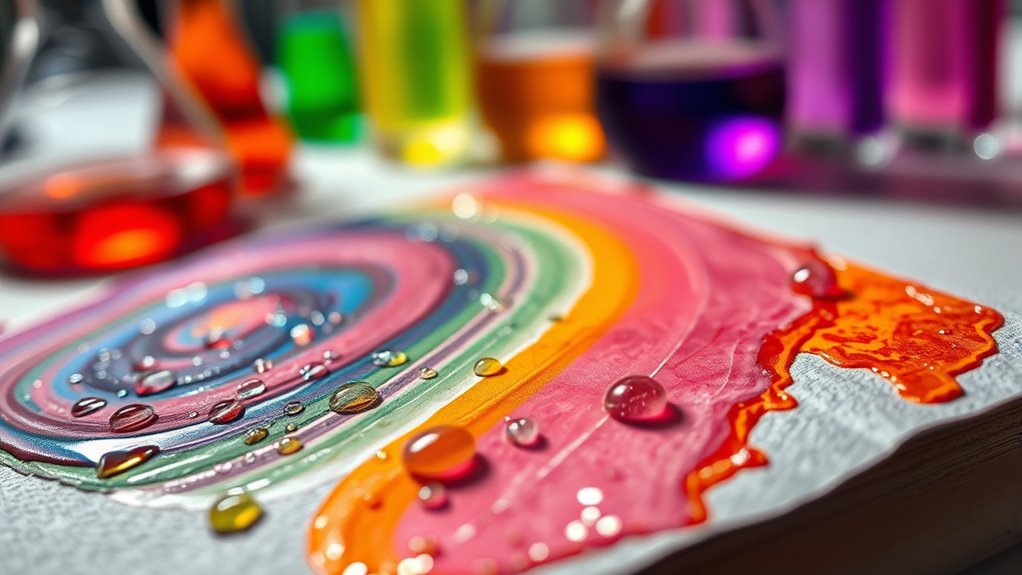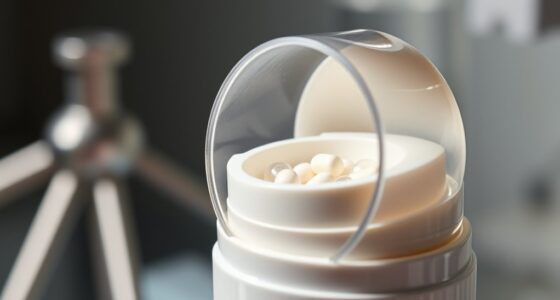The chemistry of paints and coatings involves combining pigments, binders, solvents, and additives to create durable, colorful surfaces. You’ll find different formulations for various uses, like latex or epoxy paints, with processes such as drying and curing defining their final properties. Modern coatings also focus on environmental safety, innovations, and smart technologies. Exploring the complex interactions of these ingredients reveals how they protect, decorate, and enhance surfaces—if you’re curious, there’s more to discover behind each formulation.
Key Takeaways
- Paints consist of pigments, binders, solvents, additives, and extenders, each influencing color, durability, adhesion, and application properties.
- The drying process involves solvent evaporation and film formation, followed by curing through chemical cross-linking for durability.
- Different types of paints (latex, alkyd, epoxy, acrylic, silicone) are formulated for specific applications based on their chemical composition.
- Environmental standards regulate VOC emissions, promoting eco-friendly formulations like water-based and bio-based paints with reduced hazardous chemicals.
- Advanced technologies such as nanocoatings, self-healing polymers, and smart coatings enhance performance, sustainability, and functional properties of paints.
Components of Paints and Their Functions
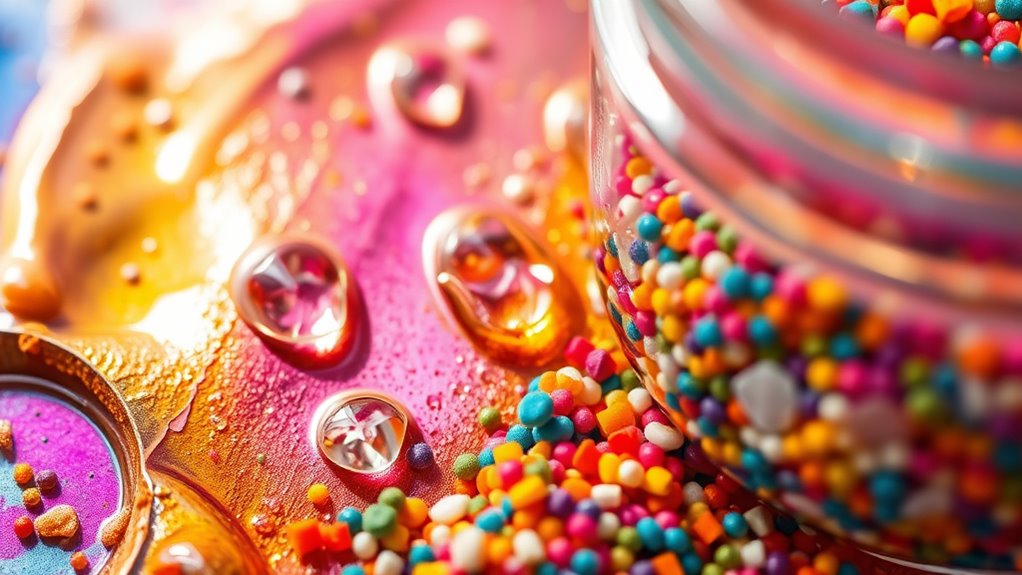
Paints are composed of several key components, each serving a specific function to guarantee the final coating performs as intended. You’ll find pigments that give color, opacity, and UV resistance, with inorganic pigments like titanium dioxide dominating for their brightness and durability. Organic pigments such as azo and phthalocyanine derivatives are also used. Binders, mainly resins like acrylic or epoxy, form a film that adheres pigments to surfaces while determining durability, flexibility, and adhesion. Solvents adjust the paint’s viscosity, with water-based carriers becoming more popular for eco-friendliness, while VOCs like toluene evaporate during curing. Additives enhance drying, texture, and weather resistance, whereas extenders like calcium carbonate reduce costs and improve surface properties, ensuring the paint performs reliably once applied. Additionally, the formulation of paints often involves specialized ingredients that improve properties such as adhesion and resistance to environmental factors. These ingredients can also influence the paint’s chemical stability, ensuring long-term performance and durability on various surfaces. Incorporating industry standards and regulations is crucial to meet safety and environmental requirements for different applications. Understanding paint formulation techniques helps in developing coatings tailored for specific conditions and surfaces. Furthermore, application methods play a vital role in achieving the desired finish and performance of the coating.
Types of Paints and Their Applications
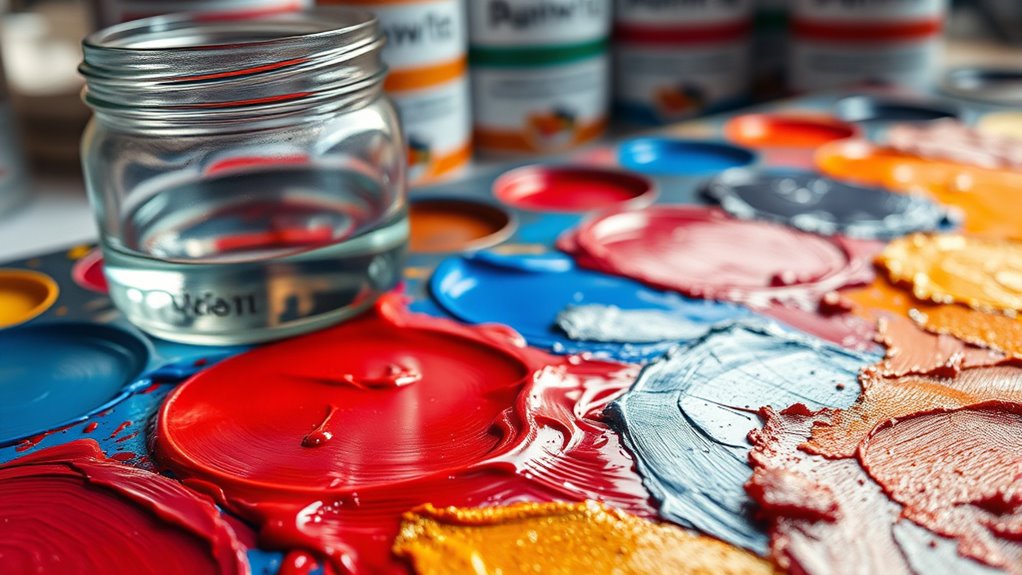
Have you ever wondered why certain finishes look perfect for specific projects? The type of paint you choose depends on its composition and intended use. Latex paints are ideal for interiors and exteriors because they dry fast and are water-based. Alkyd paints, with their durability and high gloss, suit outdoor furniture and trim. Epoxy paints excel in industrial settings due to their chemical and abrasion resistance. Acrylic paints are flexible and water-resistant, making them popular in artistic and decorative applications. Silicone paints withstand high temperatures, perfect for heat-exposed surfaces. Finishes also vary: gloss paints add shine to furniture, matte hides imperfections, and satin offers a balanced sheen. Selecting the right paint guarantees your project looks great and lasts longer.
The Chemistry of Drying and Curing Processes
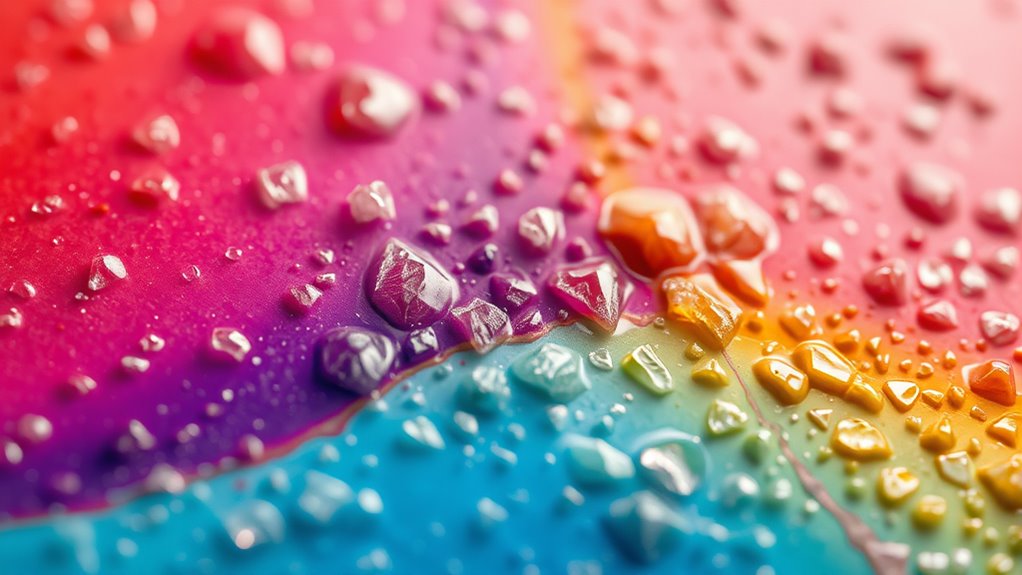
Ever wondered what makes a freshly applied coat of paint harden and last? It all begins with drying, where solvents or water evaporate, leaving the paint semi-dry. As drying progresses, the film levels out, and particles coalesce, forming a smooth surface. A thin skin develops as solvents escape, marking the skinning stage, followed by the dry-to-touch phase—when the surface feels dry but still contains volatile materials underneath. Factors like temperature, humidity, and air flow influence drying rates. Curing, however, involves chemical reactions, primarily cross-linking of polymer chains, which solidifies the coating into a durable, cohesive film. This process can take days or weeks, depending on the paint type and conditions. Proper drying and curing are essential for strength, adhesion, and resistance of your finished coating.
Specialized Coatings and Their Uses
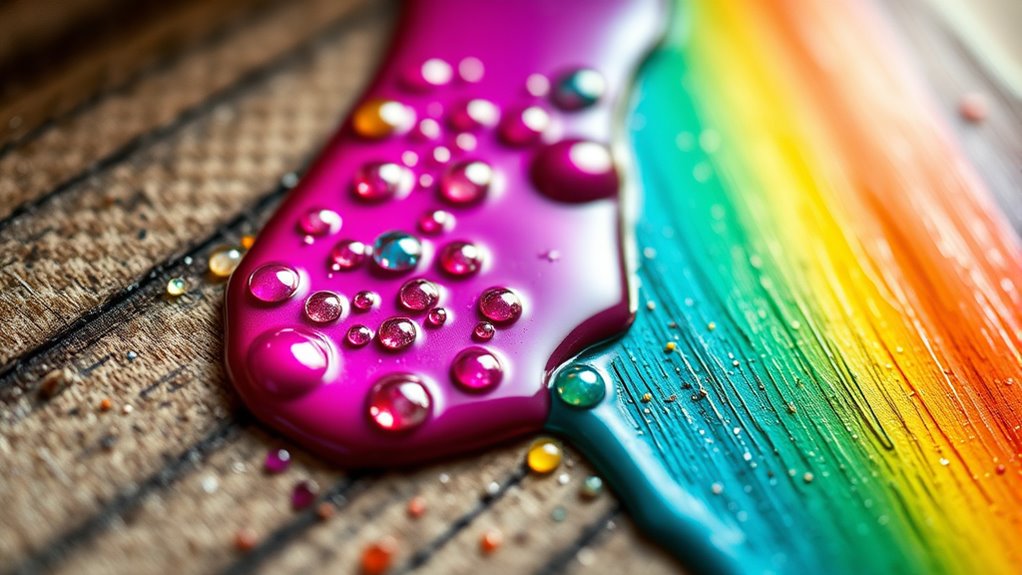
Specialized coatings are formulated to meet specific performance needs across various industries. For example, polyurethane coatings offer high abrasion resistance and flexibility, making them perfect for flooring and automotive parts. Epoxy coatings provide superior adhesion and chemical resistance, ideal for industrial floors and metal substrates. Acrylic coatings deliver UV stability and color retention, suitable for exterior surfaces and roofing. Zinc-rich coatings protect steel structures through galvanic action, preventing corrosion in marine and infrastructure environments. Heat-resistant coatings withstand extreme temperatures, used on engine components and exhaust systems. These coatings serve diverse applications: waterproofing roofs, preventing corrosion on metal surfaces, protecting concrete floors, and shielding automotive parts. Their unique properties help improve durability, safety, and aesthetics across industries, ensuring materials perform under demanding conditions. Additionally, understanding the chemical composition of these coatings is essential for selecting the right type for specific applications. Recognizing the role of additives in coating formulations can further enhance their performance characteristics. Moreover, knowledge of low light office plants can be useful for creating conducive environments for workers involved in coating application and maintenance. Incorporating specialized testing methods is also crucial for verifying coating performance before deployment in critical settings. Being aware of ethical hacking principles can help ensure cybersecurity measures are in place for digital systems used in manufacturing and monitoring coating processes.
Environmental Considerations and Regulatory Standards
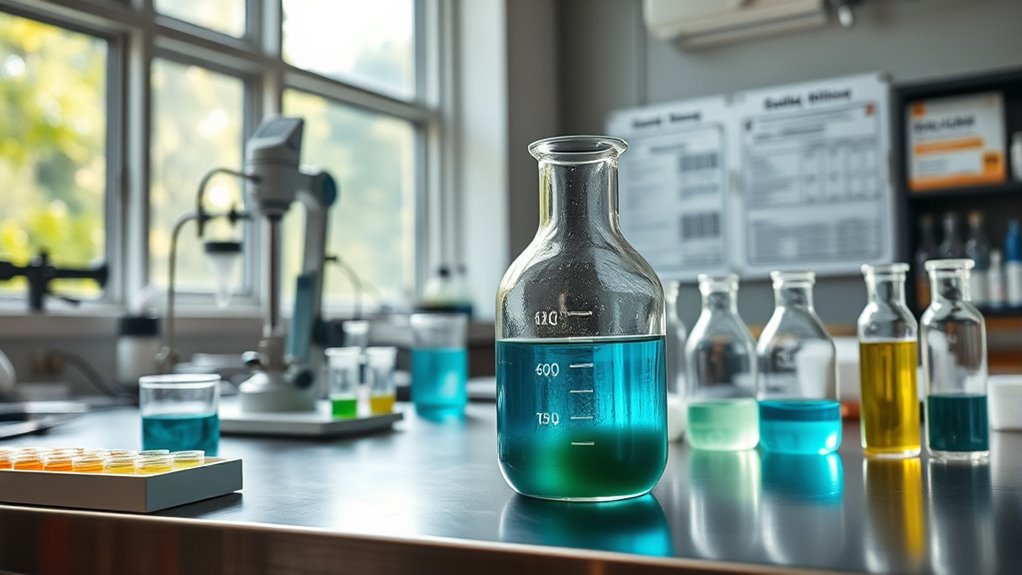
Environmental considerations and regulatory standards play a critical role in shaping the paint and coatings industry today. You need to understand that VOC emissions from paints contribute to air pollution, so regulations like the Clean Air Act limit these harmful compounds. Agencies monitor industry practices to ensure compliance, requiring permits for major HAP emitters and setting strict emission standards. Safer formulations are promoted through certifications like Green Seal, which restrict hazardous chemicals and support sustainability goals. By adopting green chemistry, you help improve air quality and create healthier environments. Industry efforts to reduce VOCs and hazardous pollutants align with policies that enforce proper waste disposal and emission controls. Staying compliant not only avoids penalties but also supports environmental and public health initiatives. Additionally, ongoing research and industry innovation are essential to developing new environmentally friendly coatings that meet evolving standards, highlighting the importance of sustainable chemistry in this field. Incorporating advanced manufacturing techniques can further minimize emissions and improve environmental performance. Moreover, transparent reporting and regulatory compliance are vital for maintaining public trust and industry accountability.
Innovations in Paint Chemistry and Sustainability
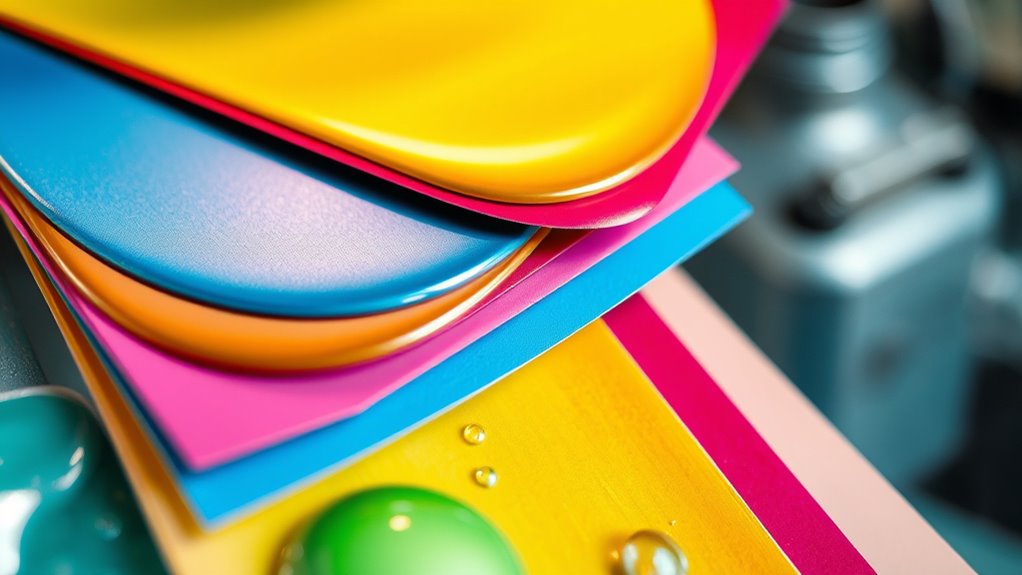
Innovations in paint chemistry are driving the industry toward greater sustainability by improving process efficiency and reducing harmful emissions. You’ll find companies focusing on process optimization to conserve resources and cut waste through recycling and smarter manufacturing. Reducing volatile organic compounds (VOCs) remains a priority, leading to the development of low- and zero-VOC paints that improve indoor air quality. Natural ingredients like bio-based binders, oils, and pigments are increasingly replacing synthetic options, meeting consumer demand for eco-friendly products. Technologies like nanocoatings extend paint durability, decreasing reapplication needs, while reflective coatings help lower energy consumption by maintaining building temperatures. Startups like Auro USA and Cypris Materials are pioneering plant-based, sustainable materials that eliminate toxic substances, pushing the industry toward more environmentally responsible coatings. Forsale 100.
Future Trends in Paint and Coating Technologies

Future trends in paint and coating technologies are shaping a more sustainable and functional industry by integrating advanced formulations, smart materials, and AI-driven processes. Water-based paints lead the charge to cut VOC emissions and improve air quality, while powder coating recycling systems reduce waste. Bio-based resins gain popularity as renewable alternatives to petroleum binders, and low-carbon methods use energy-efficient curing and electric machinery. Antimicrobial additives boost durability without harmful biocides. Advanced coatings now include self-healing polymers, graphene-infused formulas, and thermochromic or photochromic paints that change color with temperature or UV exposure. Conductive, anti-static, and IoT-enabled coatings enhance electronics. AI optimizes formulas, predicts maintenance, and controls quality, ensuring precision and sustainability in manufacturing. These innovations drive a future of smarter, greener paints and coatings. Ice cream is a popular treat among many consumers, and trends in flavors and ingredients continue to evolve, reflecting consumer preferences for unique and exotic tastes.
Frequently Asked Questions
How Do Different Pigments Affect Paint Durability and Color Stability?
Different pigments substantially impact your paint’s durability and color stability. Inorganic pigments like titanium dioxide resist UV damage, keeping colors vibrant longer. Active pigments such as zinc oxide enhance wear resistance by preventing degradation. Metallic and specialty pigments reflect heat and reduce fading, especially outdoors. Choosing high-quality, photo-stable pigments and ensuring proper dispersion helps maintain consistent color and prevents chalking or oxidation, so your paint stays durable and looks fresh over time.
What Role Do Additives Play in Enhancing UV Resistance?
Additives substantially boost UV resistance by absorbing harmful UV rays, converting the energy into heat, and preventing damage to the material. You’ll find UV absorbers, like benzophenone or triazines, that shield the surface, while radical scavengers and antioxidants neutralize free radicals that cause deterioration. By carefully selecting and optimizing these additives, you can extend the lifespan of your coatings, maintaining their appearance, strength, and protective qualities against UV-induced degradation.
How Are Nanomaterials Incorporated Into Modern Coatings?
Imagine weaving a tapestry of tiny, invisible warriors into your coating. You incorporate nanomaterials through methods like dip/spin coating, ultrasonic dispersion, layered spraying, PVD, or sol-gel processing. These techniques scatter and absorb harmful rays, creating an impenetrable shield. As you apply them, they distribute evenly, forming a seamless, high-performance armor that boosts durability, UV resistance, and self-cleaning, turning your coating into a fortress against wear and environmental damage.
What Are the Challenges in Developing Biodegradable Paint Formulations?
You face several challenges when developing biodegradable paint formulations. You need to balance performance with environmental friendliness, ensuring the paint remains durable without traditional preservatives. Finding renewable, natural ingredients that prevent microbial growth is tough, especially without compromising quality. Additionally, scaling up these eco-friendly options costs more and involves complex technology. You also have to meet strict regulations while satisfying market demand for sustainable, high-performance paints.
How Do Curing Methods Influence the Final Mechanical Properties of Coatings?
You should know that curing methods directly influence your coating’s mechanical properties. Thermal curing, for example, increases hardness and durability by creating strong cross-links, while UV curing offers fast setting with good chemical resistance. Electron beam curing is gentle on heat-sensitive substrates, maintaining flexibility. The right method guarantees your coating adheres well, resists wear, and maintains its intended strength, ultimately enhancing its performance and lifespan.
Conclusion
Just as a brush brings a blank canvas to life, understanding paint chemistry transforms simple materials into lasting art. Your choices in coatings shape not just surfaces, but the future—protecting, beautifying, and reflecting your values. By embracing innovations and sustainability, you hold the power to paint a better tomorrow. Remember, every coat you apply is a symbol of progress, turning the everyday into a masterpiece of environmental care and technological advancement.
